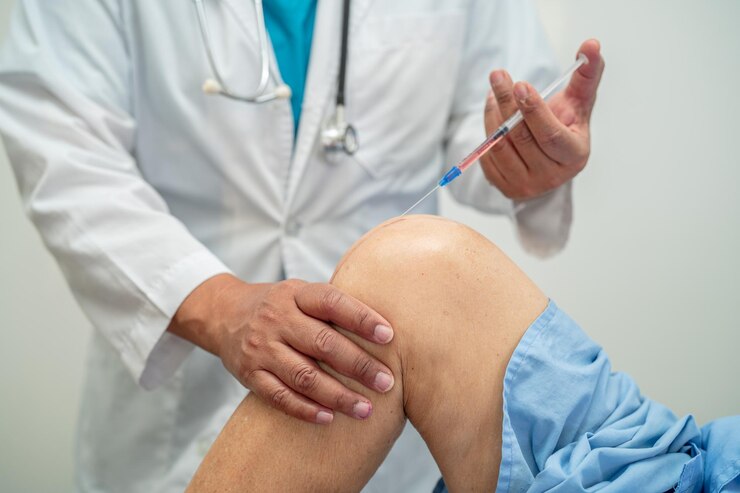Shockwave therapy was first used for treatment 30 years ago. It is only during the last 10 years that shockwave therapy has been widely used for the treatment of issues relating to the tendons and muscles. The most frequently performed type of shockwave therapy for clinical treatment is radial shockwaves. The waves are high-energy acoustic. Radial shockwaves are transmitted through the skin’s surface. The waves then radially spread into the body.
The response of the body is an increase in metabolic activity centering around the site treated. This expedites and enhances the natural healing process. Although shockwave therapy is not an immediate cure, the therapy has been helpful for numerous individuals with stubborn plantar fasciitis or patella and achilles tendon issues. The treatment appeared to speed up the recovery of several different issues. The evidence relating to the efficacy of the treatment is continuing to expand.
Shockwave therapy has been effective for the treatment of musculoskeletal disorders of the lower limbs including Achilles, patella and gluteal tendinopathy, calcific tendinitis located in the shoulders, plantar fasciopathy (plantar fasciitis) and tennis elbow.
The History of Shockwave Therapy
Shockwave therapy was initially created for the treatment of kidney stones. A machine emitted high-energy ultrasonic waves to break down the hard deposits of calcium. The deposits are what cause kidney stones. Only a short time later, research was conducted to determine if ultrasonic shockwaves were a potential treatment for other issues linked to calcium deposits such as calcific shoulder tendonitis. Eventually, researchers decided to investigate shockwave therapy as a possible treatment for injuries unrelated to a calcium buildup.
This was at approximately the same time physicians started to understand the causes of chronic fascia and tendon injuries including plantar fasciitis, patellar tendonitis and achilles tendonitis. The cause of all of these conditions was determined to be impaired healing and damage to the fibers of the fascia or tendon as opposed to just general inflammation. The belief was shockwaves had the ability to induce the correct amount of stress to the damaged area to retrigger the process of healing.
The early studies showed a lot of promise. Small-scale studies showed extracorporeal shockwave therapy provided benefits for individuals with chronic cases of plantar fasciitis, patellar tendonitis and Achilles tendonitis. Much larger review studies and clinical studies were still necessary for determining the effectiveness of extracorporeal shockwave therapy as a treatment for these types of injuries. Several of the earliest studies were extremely skeptical.
A paper was written in Germany in 2001 at Phillips University by R. Boddeker among others. The paper showed clinical trials treating plantar fasciitis using extracorporeal shockwave therapy lacked control groups and were poorly designed. After several years had passed, the studies being published become much more positive.
Three of the Most Common Running Injuries
Shockwave therapy is believed to be an effective treatment for several of the most common running injuries. The specific conditions are detailed below.
Shin Splints: Shin splints are referred to as medial tibial stress syndrome. The characteristics of the condition are pain located in the general shin area between the ankle and knee. Shin splints is an extremely difficult condition to treat, although common among both athletes and runners. Shockwave therapy offers a painless and non-invasive treatment option.
As a treatment specifically for injuries of the soft tissue and tendon, shockwave therapy has been proven extremely effective for treating a wide range of different conditions. The blood flow is stimulated by the shockwaves resulting in the tissues healing at the cellular level. The healing process is effectively reset to help the body eliminate injury or inflammation.
Plantar Fasciitis: The most common type of heel pain is plantar fasciitis. The ligamentous tissue band connecting the heel to the toes is called the plantar fascia. The band provides support for the arch of the foot. When too much strain is placed on the plantar fascia, it may weaken or become inflamed or swollen. The result is foot pain in the sole of the foot and heel when the individual walks in a certain way or is standing.
Achilles Tendinopathy: Achilles tendinopathy causes swelling, stiffness and pain in the Achilles tendon. The tendon is where the calf muscles of the individual are attached to the heel. The belief is this injury results from the repetition of small injuries or microtrauma to the Achilles tendon. The belief is the Achilles tendon is not completely healed after receiving an injury. As injuries occur over time, the development of Achilles tendinopathy may result.
Studies on Extracorporeal Shockwave Therapy and Plantar Fasciitis
In 2006, the first major study was published by D. Scot Malay along with his colleagues. The study was a placebo-controlled, double-blinded trial. Neither the physicians examining the participants or the patients knew who was receiving a fake shockwave therapy session and who received the genuine treatment. Every participant in the study had plantar facilities not responding to any of the conservative treatments. The study encompassed a three-month follow-up.
Heel pain was reduced for the control group during the follow-up period. The group receiving genuine extracorporeal shockwave therapy was the experimental group. These participants showed more significant improvement based on the assessments of the physician and the individual participants. According to the authors, no adverse outcomes resulted from the shockwave therapy for one full year after completion of the treatment.
The reason this is important is that one of the alternative treatments for individuals with chronic plantar fasciitis is surgery. There is a major risk of complications with surgery. In 2007, Ronald De Vera Barredo, James Farris and Dale Menna at Arkansas State University and Tennessee State University confirmed the efficacy of shockwave therapy for the treatment of plantar fasciitis in a review. In the review study, they wrote extracorporeal shockwave therapy effectively treated chronic plantar fasciitis.
High-energy extracorporeal shockwave therapy was noted as offering a faster resolution and higher rate of success for resolving symptoms in comparison to the low-energy version of the therapy.
Extracorporeal Shockwave Therapy and Achilles Tendonitis
There have been several randomised trials showing success for the treatment of Achilles tendonitis. Other studies have not found any benefits for the condition using shockwave therapy. Extracorporeal shockwave therapy has not been endorsed by any major review study at this time as a beneficial option for Achilles tendonitis. A. Brian Thomson, Warren Dunn and Robert Magnussen of Vanderbilt University conducted a review in 2009.
The possibility was left open that extracorporeal shockwave therapy is a potentially useful, noninvasive option for the treatment of Achilles tendonitis. The review stated additional studies needed to be conducted. There are currently on treatment specifics or consensus for using shockwave therapy for the treatment of Achilles tendonitis such as the number of treatments necessary or the energy level. For this reason, the comparison of studies is difficult.
The Benefits of Shockwave Therapy for Running Injuries
There are good reasons for the belief shockwave therapy is more beneficial than either surgery or a steroid injection. There is evidence CSI (corticosteroid injections) can result in the degradation of the tendon’s integrity. Recent literature has referred to this as tendon toxic, especially if used repeatedly. This is the reason using corticosteroids for the treatment of load-bearing tendons including the Achilles is usually considered inappropriate.
The administration of shockwave therapy right to the load-bearing tendon has shown no damage to the integrity of the structure of the tendon, and has resulted in practically no side effects. When examined from the sporting point of view, significant abstinence from sporting activities is not necessary. This means shockwave therapy can be performed in addition to competitions and exercise-based interventions. The longest rest period recommended prior to post-treatment is generally 48 hours.
Steroid injections generally require a rest period of five to seven days with weeks often necessary when the individual has surgery. Shockwave therapy has been used successfully for both non-elite and elite marathon runners. The option is extremely useful when compared to more standard physiotherapy treatment. Marathon runners regularly running more than one hundred miles every week have been able to manage injuries and continue running due to shockwave therapy.
Shockwave therapy has helped marathon runners manage numerous conditions including patella tendinopathy, plantar fasciitis and proximal hamstring tendinopathy with no disruption in training. Mani-Babu conducted a systematic review in 2014. He determined Shockwave therapy offers an effective adjunctive role. He noted enough high-quality studies are now available to evaluate the effectiveness of extracorporeal shockwave therapy. He believes there is enough evidence to show shockwave therapy is an effective treatment for lower limb tendinopathies and flexibility management.
The Disadvantages of Extracorporeal Shockwave Therapy
The first minute of the session, shockwave therapy can be either a little uncomfortable or may cause pain. The average session is usually five minutes or less. The complete treatment involves a minimum of three to six sessions. In most cases, the sessions are scheduled apart by five to 10 days. Some patients have reported immediate improvement of their symptoms. In most instances, several weeks are necessary before the patient notices an improvement in their symptoms.
Shockwave therapy is not guaranteed to be effective for everyone. The treatment is far less risky than the option of surgery or steroid injections. There are a few types of patients shockwave therapy is not appropriate for due to safety reasons. Shockwave therapy should not be received by any individuals who:
- Have an acute inflammation in the potential treatment area
- Have a tendency to haemorrhage
- Have an infection at the treatment site
- Have a severe circulatory disorder
- Have received a steroid injection within the last 30 days
- Have an open wound at the treatment site
- Have a tumour at the treatment site
- Are using an anti-coagulant spray
- Pregnant women
- Have a nerve disorder at the treatment site
- Haemophiliac patients
- Have a prosthesis
Deciding if Shockwave Therapy is a Good Treatment Option for Chronic Injuries
The treatment is still new, so the is no standardisation. This makes it difficult for researchers to determine if shockwave therapy is a useful treatment. Other studies have presented good evidence showing shockwave therapy is helpful as a treatment for plantar fasciitis and patellar tendonitis.
Evidence is also available showing the efficacy of the treatment for Achilles tendonitis. To be realistic, five to 10 years may be necessary for coherent guidelines to be developed by researchers and physicians regarding which patients should receive treatment, the appropriate injuries for treatment and the correct frequencies and energy intensity for each individual patient. Some individuals still consider extracorporeal shockwave therapy as an experimental treatment.
The treatment is considered appropriate for individuals with chronic fascia and tendon injuries not responsive to the more conservative and traditional treatments. If an individual has been suffering from a running injury for several months with no notable improvement from traditional treatments such as custom orthotics, certain stretches or eccentric exercises, there is the option of discussing shockwave therapy with a physician.
The individual should see a chiropractor they trust because the treatment protocols are dependent on each practitioner. The knowledge and experience of the physician administering the therapy will affect the chances of success. There is growing evidence suggesting shockwave therapy may be effective for running injuries.
Related Articles
- 7 Sporting Injuries Your Chiropractor Can Help With
- Shockwave Therapy FAQs
- Types of Tendonitis that Shockwave Therapy Can Treat
- How Does Shockwave Therapy Work on Tendons
- Runners Knee, a Recipe for a Pain-Free Knee



